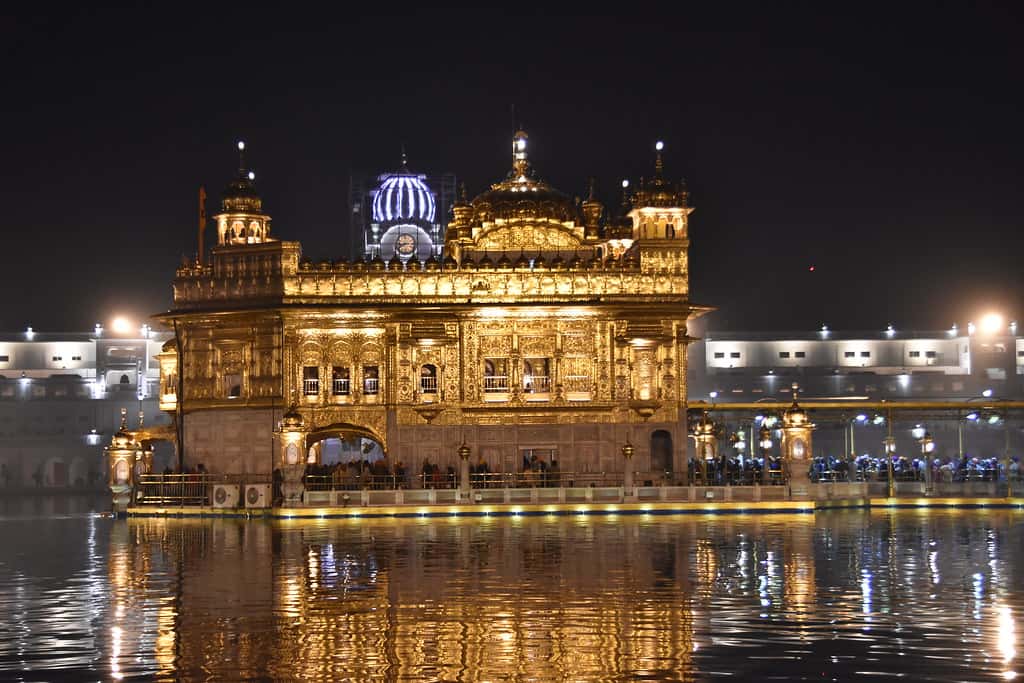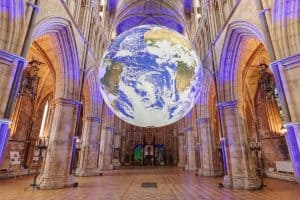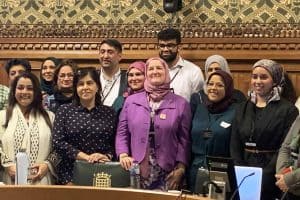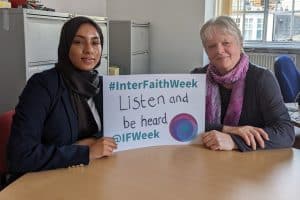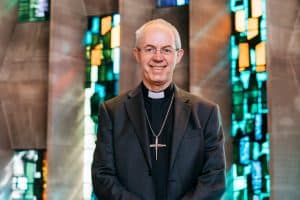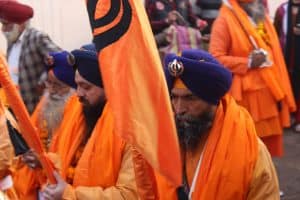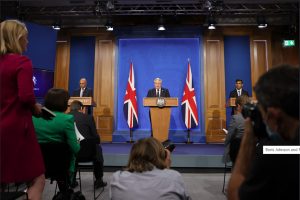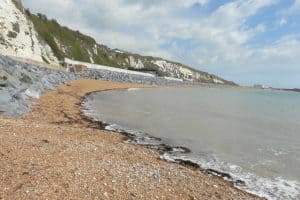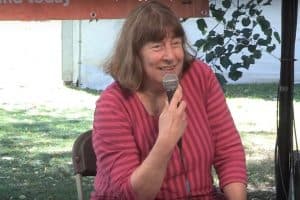by Minreet Kaur
The assault on the Golden Temple in Amritsar in June 1984, which led to thousands being killed, caused collective trauma in the Sikh community. About 250,000 Sikhs were living in the UK at this time.
The event is commonly referred to as the third Sikh holocaust. Gurdwaras and organisations observe the anniversary with annual memorial prayer recitals and many have galleries of the martyred Sikhs. In addition, there is an annual protest march and rally London. This year with restrictions on large gatherings, only about 200 people attended the rally in Trafalgar Square.
The assault ‘Operation Blue Star’ took place during a pilgrimage when Sikhs had assembled to commemorate the martyrdom of their fifth guru, Guru Arjan Dev. The Indian government believed that there was a campaign of violence by Sikh extremists who had taken refuge in the gurdwara precincts. The Sikh historian, Harjinder Singh, says an Indian government White Paper of July 1984 ‘The Punjab Agitation’ said no arrest warrants had been issued for anyone in the Gurdwara.
A court ruling in December 2019 by the Amritsar District and Sessions Judge Gurbir Singh said: “There is no evidence that the army made any announcements asking ordinary civilians to leave Golden Temple complex before launching the operation in 1984 . . . The event underlines the human rights violations by troops during the operation.”
There are continuing calls for justice on relation to the attack. Tanmanjeet Singh Dhesi, the Labour MP for Slough in Berkshire, has called for an independent judge-led public inquiry into the UK’s involvement in the massacre. And Preet Kaur Gill, the Labour MP for Birmingham Edgbaston, has said that many are still seeking truth and justice.
The Sikhs deeply affected by the event say their pain would heal if the government declared that thousands that died, not just hundreds listed in official figures. They do not feel they have had the support from the British government and in India they say it is impossible to get any justice.
Amrit Kaur Bhamra, 64, from Slough, travelled regularly to Amritsar to spend up to six weeks with her in-laws about a mile from the temple. They would walk barefoot to the temple to listen to the morning prayers and Kirtan, the reading of scriptures.
She was 28 when she visited six months after the 1984 assault and recalls a strange feeling of dread. She had heard stories of arson, rape and torture. The curfew was still on and there were police and soldiers with guns patrolling the streets in the evenings.
“You are desperately trying to control your tears and to find comfort in those that are around you,” she said. “That was the feeling that I had as I walked from my home feeling scared to go and seeing the state of my beloved temple, that it was not sacred any more, polluted for ever with screams and blood.
“It was almost a relief as I entered that it was still there in its glory. But it was not the same any more. The usual hustle and bustle of communal prayer and smiles had been replaced by silence of mutual grief. Sangat [Sikh followers] from all walks of life were helping to clean up mountains of bricks and mortar and marble tiles. Their faces were blank and all feelings and emotions had been drained. Their eyes did not meet you in bliss but in acknowledgement of the horror and devastation that had happened. Some faces just nodding in disbelief. Some quietly prayed while serving water. Some sat in groups trying to find answers, some in disbelief.
“After helping to clean up as much I could, I walked around — touching bullet holes in walls. Our blessed water was now polluted. There was an unforgettable stench of unseen raw blood that had seeped into the atmosphere. To this day, I cannot go past a butcher without being reminded of what I had smelt.
“Before leaving that day, I took two very thin small bricks from the foundations that had been bulldozed. At the airport I was asked to leave them behind. I cannot ever forget the innocent souls of each child woman and man that were brutally murdered on that day and their screams of fear will always be embedded in each brick.
“To this day, I have not been back. The event has left deep scars in our hearts and souls —wounds that cannot constantly be re-plastered. For me personally, healing can only begin with full and honest disclosure from all parties that were involved.”
Harjinder Singh, 42, an author with Akaal Publishers, said: “I was six years old in 1984 and attended the first protest march in the UK. All my relatives attended and we were three to a seat on coaches.
“In 1988 I visited Sri Harmandir Sahib [the Temple] and saw bullet marks. This created a passion in me to never forget the murder of the Sikhs by India. I turned this passion into telling the truth about what happened in lectures, articles and books.”
Sukhwinder Singh, now living in the West Midlands, said: “I was six at the time of the attack. I was at the school next to the temple complex. We were playing outside in the playground, when all of a sudden we heard a large bang which I later knew to be the sound of gunfire. It was very loud and it terrified all of us. Everybody just stopped playing. We had never heard anything so loud before. We were used to hearing loud fireworks but this was a very different, very eerie sound.
“We were then told to quickly get our things and leave the school. There was a rickshaw that would take us back to our house. My younger cousin and I managed to get on the rickshaw, but my older cousin was left behind.
“We couldn’t go to our house because we were trapped at a junction. There were government forces placed at the junction firing towards our left. The junction was too dangerous to cross. The rickshaw man pleaded with them to stop firing but they did not stop. He then decided to take a chance and just run across.
“As we were crossing the junction I looked to my left just to see what they were shooting at and I still remember to this day that there were just people running to save their lives. I remember a woman climbing over bodies who then fell herself.
“We eventually made it to the house and my grandmother went to get my older cousin. When she got back she told us how she had seen the military sweeping the streets. She told us that there was one boy probably the age of 13 or 14 with a school bag, trying to get to his house.
“The army stopped him they said, ‘Shoot him!’ My grandma intervened and said, ‘Why are you shooting him? He’s only a child.’ And as she interrupted them the boy managed to run away.
“I still remember the eerie sound of the gunshots, I still remember people running for their lives being shot at. I still remember that woman who fell on top of bodies lying on the road.”
Kuljit Kaur, 49, now living in Berkshire, lived in Amritsar at the time of the attack. Her parents were in the complex of the temple as her father was working in the bank at the time of the attack. They were arrested and taken to jail. Kuljit was 14. She was left with her grandparents who were all under the impression that her parents died in the attack.
“The parents had survived the attack but were sent to different jails in different parts of India. Every day her grandad would go out to find out if they were alive and on the 13th day he found that his daughter was alive. On the 20th day the army came to the house, interrogated the family and left without telling them that the father was alive. Then after four or five months in they moved the father to another jail and he was there for five years until April 1989 where he was released on bail.”
Kuljit came to the UK in 1990 and was scared and living in fear of being arrested because of how it had been for her in India. She says she has had to live with this story and her parents being called terrorists by the government when they are ordinary, simple, people whom she believes did nothing wrong. Her father was a public figure. He worked in a well-known bank, he was religious and this affected Kuljit in terms of her getting married: people wouldn’t want to marry her believing her to be the “the daughter of a terrorist”. Eventually she had an arranged marriage to someone in the UK and it is a happy one.
She said: “My mother goes into stress every time this date comes. It affects her mentally. It’s like a covered wound that will be uncovered every time this time of year.”
Her father is a strong character, he’s quite spiritual and he has faith. She goes back regularly and feels safe because she keeps herself to herself. She says there is nothing to heal this pain and that it’s a big wound that stays with her daily.
In her normal daily life, she feels well, but she does not want to talk about it and does not attend the yearly rally as it’s too painful to discuss.

